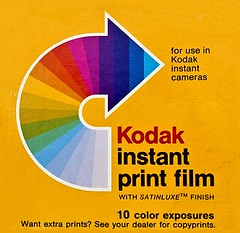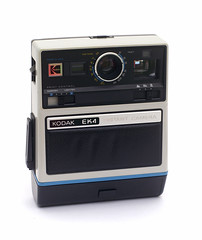Difference between revisions of "Kodak Instant"
(oops did not copy the short polaroid vs kodak suit sentences, added details on battery) |
(quick top img insert, misc.) |
||
| Line 1: | Line 1: | ||
| − | + | {{Flickr_image | |
| + | |image_source= http://www.flickr.com/photos/49656291@N00/6080561105/in/pool-camerawiki/ | ||
| + | |image= http://farm7.staticflickr.com/6193/6080561105_6a2db1fa91_m.jpg | ||
| + | |image_align= right | ||
| + | |image_text= | ||
| + | |image_by= Kenneth Dwain Harrelson | ||
| + | |image_rights= with permission | ||
| + | }} | ||
| − | Polaroid filed suit against Kodak in 1976 for patent infringement. The case dragged on for years. Kodak lost the dispute, after the ruling in 1985, Kodak announced the discontinuation of their instant photo products. | + | [[Kodak]] manufactured [[Polaroid]]'s instant film from 1963 to 1969, when Polaroid decided to manufacture its own. Kodak's original plan was to create packfilm type instant products. There were many prototypes and test runs of the film with many private demonstrations to their board. Plans changed when Polaroid in 1972 released the integral type film with the introduction of the SX70 system. Kodak decided to scrap the plans for packfilm release and focus on an integral type process. A few years later Kodak introduced its own instant film products in 1976, which was different from Polaroid's in several ways. |
| + | |||
| + | Kodak instant film was exposed from the back without a mirror, the opposite of Polaroid's film which was exposed from the front with a mirror to reverse the image. This has several advantages first the instant film is also much less complicated compared to Polaroids which has the complicated front layer that has to be transparent during exposure, opaque after the chemical spread and transparent after a development time. Other advantages include being able to use a matte finish on the face of the photo. The release of the higher ISO Trimprint series of instant products in the early 1980 also made it easy to remove the instant photo from the development pod. Without a mirror the camera are not as complex and less expensive to produce. The film path being much simpler also allow the use of mechanical crank to spread and eject the film print. | ||
| + | |||
| + | Unlike Polaroids integral film packs, Kodak's did not contain a battery, along with conventional batteries, the use of a flat J sized 4LR61 batteries were also common in the cameras. This decision was made because it would cost less per pack and because Polaroid had a long history of technical problems with batteries in film packs which led to them manufacturing their own. | ||
| + | |||
| + | Upon introduction of Kodak instant products, Polaroid filed suit against Kodak in 1976 for patent infringement. The case dragged on for years. Kodak lost the dispute, after the ruling in 1985, Kodak announced the discontinuation of their instant photo products. | ||
{{br}} | {{br}} | ||
==Cameras== | ==Cameras== | ||
Revision as of 15:57, 8 January 2012

|
| image by Kenneth Dwain Harrelson (Image rights) |
Kodak manufactured Polaroid's instant film from 1963 to 1969, when Polaroid decided to manufacture its own. Kodak's original plan was to create packfilm type instant products. There were many prototypes and test runs of the film with many private demonstrations to their board. Plans changed when Polaroid in 1972 released the integral type film with the introduction of the SX70 system. Kodak decided to scrap the plans for packfilm release and focus on an integral type process. A few years later Kodak introduced its own instant film products in 1976, which was different from Polaroid's in several ways.
Kodak instant film was exposed from the back without a mirror, the opposite of Polaroid's film which was exposed from the front with a mirror to reverse the image. This has several advantages first the instant film is also much less complicated compared to Polaroids which has the complicated front layer that has to be transparent during exposure, opaque after the chemical spread and transparent after a development time. Other advantages include being able to use a matte finish on the face of the photo. The release of the higher ISO Trimprint series of instant products in the early 1980 also made it easy to remove the instant photo from the development pod. Without a mirror the camera are not as complex and less expensive to produce. The film path being much simpler also allow the use of mechanical crank to spread and eject the film print.
Unlike Polaroids integral film packs, Kodak's did not contain a battery, along with conventional batteries, the use of a flat J sized 4LR61 batteries were also common in the cameras. This decision was made because it would cost less per pack and because Polaroid had a long history of technical problems with batteries in film packs which led to them manufacturing their own.
Upon introduction of Kodak instant products, Polaroid filed suit against Kodak in 1976 for patent infringement. The case dragged on for years. Kodak lost the dispute, after the ruling in 1985, Kodak announced the discontinuation of their instant photo products.
Cameras

|
| Kodak EK4 image by Steve Harwood (Image rights) |
Kodak Instant PR10/PR144
|
Kodamatic Trimprint HS144
|
Film
Kodak Instant ISO 150 film
- PR-10
- PR-10 Satinluxe a matte finish film
- PR-144 (replaced PR10)
Kodamatic Instant ISO 300
- HS144-10 Trimprint
- AVS 144-10 Instagraphic slide film
- AVP 144-10 Instagraphic print film
- ID 144-10 -2 Readyprint ID system